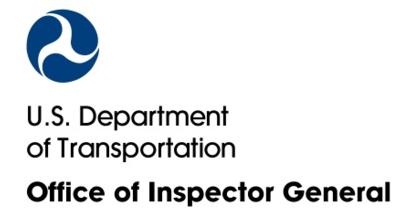Tue, Nov 22, 2016
Report Prepared At The Request Of Senate Transportation Committee Leadership
A new report released by the FAA Inspector General indicates that the full cost of the implementation of NextGen is still not known, nor are the overall benefits of the program.

In its report summary, the IG said that the report was prepared at the request of the Chairman and Ranking Member of the Senate Committee on Commerce, Science, and Transportation. The report indicates that to meet its goals for the Next Generation Air Transportation System (NextGen), the FAA identified six “transformational” programs. These programs will provide a platform for new capabilities such as a precise satellite-based surveillance system and digital data communications for air traffic controllers and pilots.
FAA has invested over $3 billion in these six programs since 2007, but has faced implementation challenges. Cost estimates for the transformational programs, as currently defined, now total over $5.7 billion and timelines extend beyond 2020. As requested by the Chairman and Ranking Member of the Senate Committee on Commerce, Science, and Transportation, the IG provided an update to its 2012 report, which identified a lack of finalized program requirements and program costs, schedules, or performance baselines for the six transformational programs.
Since the 2012 report, the IG says the FAA has made some changes to the cost and schedules of the six transformational programs. All programs are now initially baselined, but total costs and timelines remain unclear. The FAA continues to use a segmented approach for the transformational programs, which reduces risks in the near term but masks how much each program will ultimately cost, when planned capabilities/benefits will be delivered, how many segments the programs will have, and when each program will be completed.
However, the FAA has not adjusted anticipated benefits for its transformational programs, and many benefits remain uncertain for improving the flow of air traffic and reducing Agency operating costs. For NextGen to realize its full benefits, airspace users must decide to make investments not only in avionics but in pilot and crew training. FAA originally identified the transformational programs as efforts that would fundamentally change the way the Agency would manage air traffic. However, our review has found that, at least until 2020, most of the transformational programs will not transform how air traffic is managed in the National Airspace System.
The IG says it made one recommendation to FAA help it better address these ongoing issues. The FAA non-concurred with our recommendation, and the agency has been asked to reconsider its response.
More News
“In recent years, park officials have observed a rise in illegal drone activity, which they attribute to the increasing affordability and availability of consumer drones. In >[...]
Aero Linx: Aeronautical Repair Station Association (ARSA) ARSA is devoted to the worldwide civil aviation maintenance industry—from its global corporations to the small, inde>[...]
During Cruise Flight At 4,500 Ft, The Engine Stopped Producing Power Without Any Warning On October 4, 2025, about 2130 central daylight time, a Lancair 320 airplane, N431M, was de>[...]
With The eSPRG Only Weeks Away From Its Start Date, A-AF Will Help To Support Sport Flyers, Worldwide With the all-new and all-digital SportPlane Resource Guide getting ready for p>[...]
Also: USAF Pilots, Advanced Aircrew Academy, ATC Hiring, Hop-A-Jet Sues Pan American is attempting a comeback. Aviation merchant bank AVi8 Air Capital, alongside Pan American Globa>[...]
 Aero-News: Quote of the Day (10.27.25)
Aero-News: Quote of the Day (10.27.25) ANN's Daily Aero-Linx (10.27.25)
ANN's Daily Aero-Linx (10.27.25) NTSB Prelim: Lancair 320
NTSB Prelim: Lancair 320 Airborne Programming Continues Serving SportAv With 'Airborne-Affordable Flyers'
Airborne Programming Continues Serving SportAv With 'Airborne-Affordable Flyers' Airborne-Flight Training 10.23.25: PanAm Back?, Spirit Cuts, Affordable Expo
Airborne-Flight Training 10.23.25: PanAm Back?, Spirit Cuts, Affordable Expo



